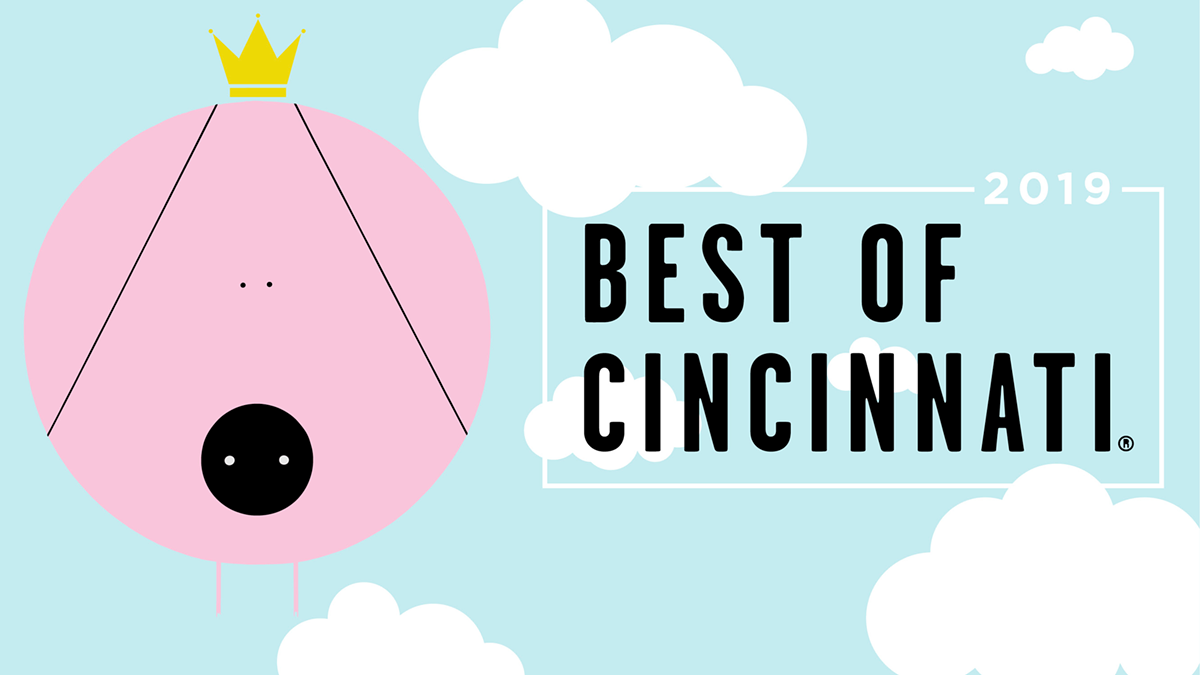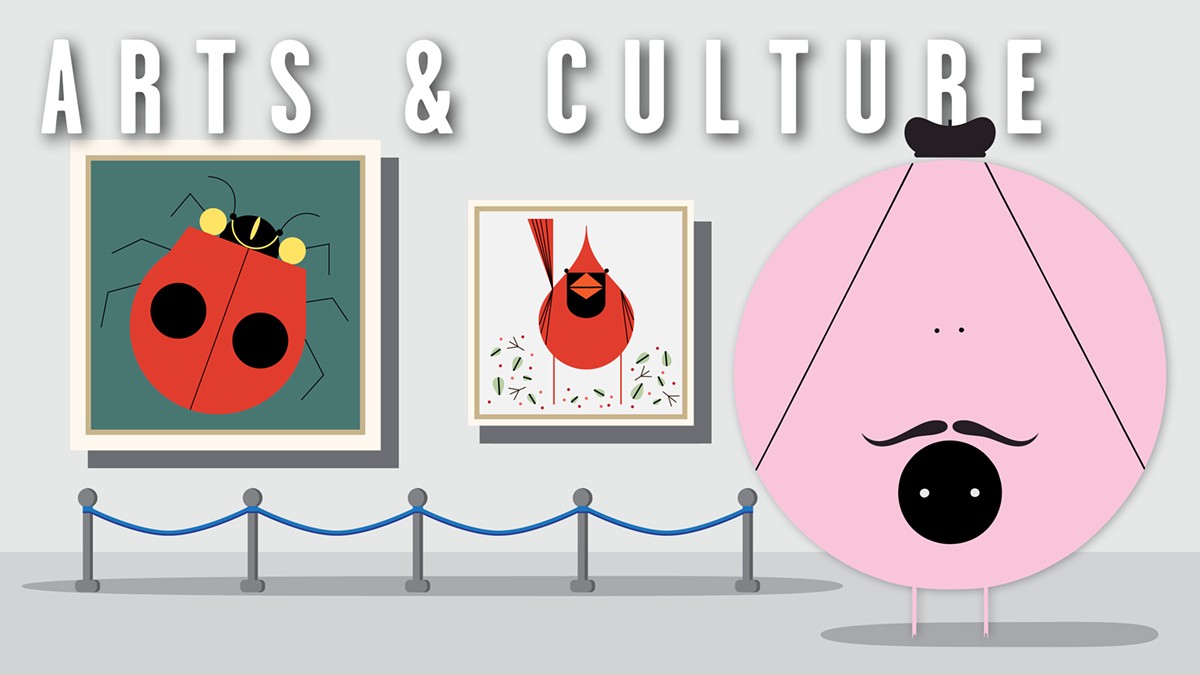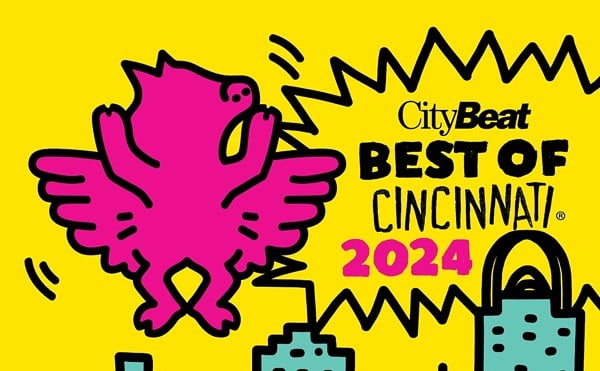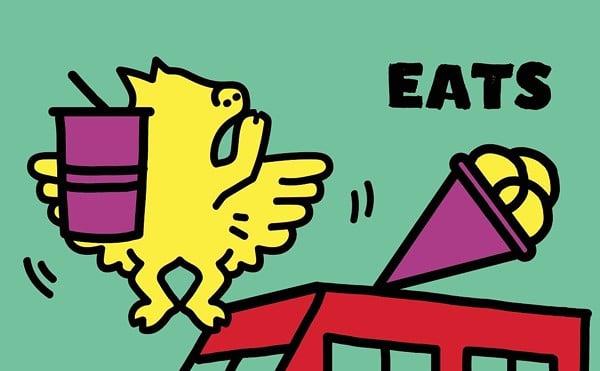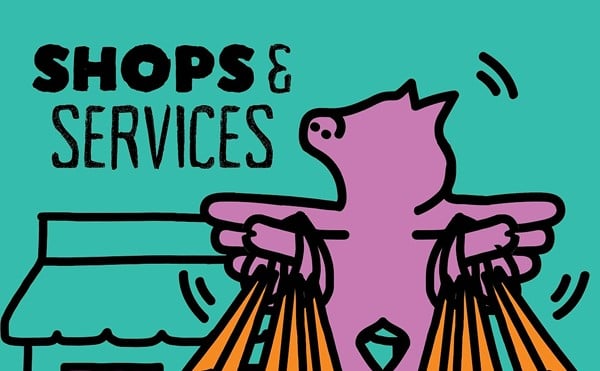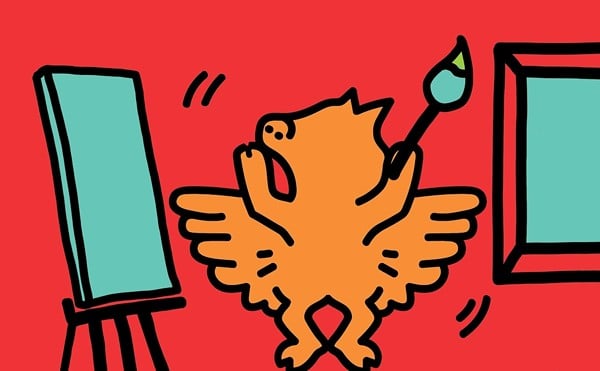2. Actors Theatre of Louisville in Louisville, Kentucky
3. Pioneer Playhouse in Danville, Kentucky
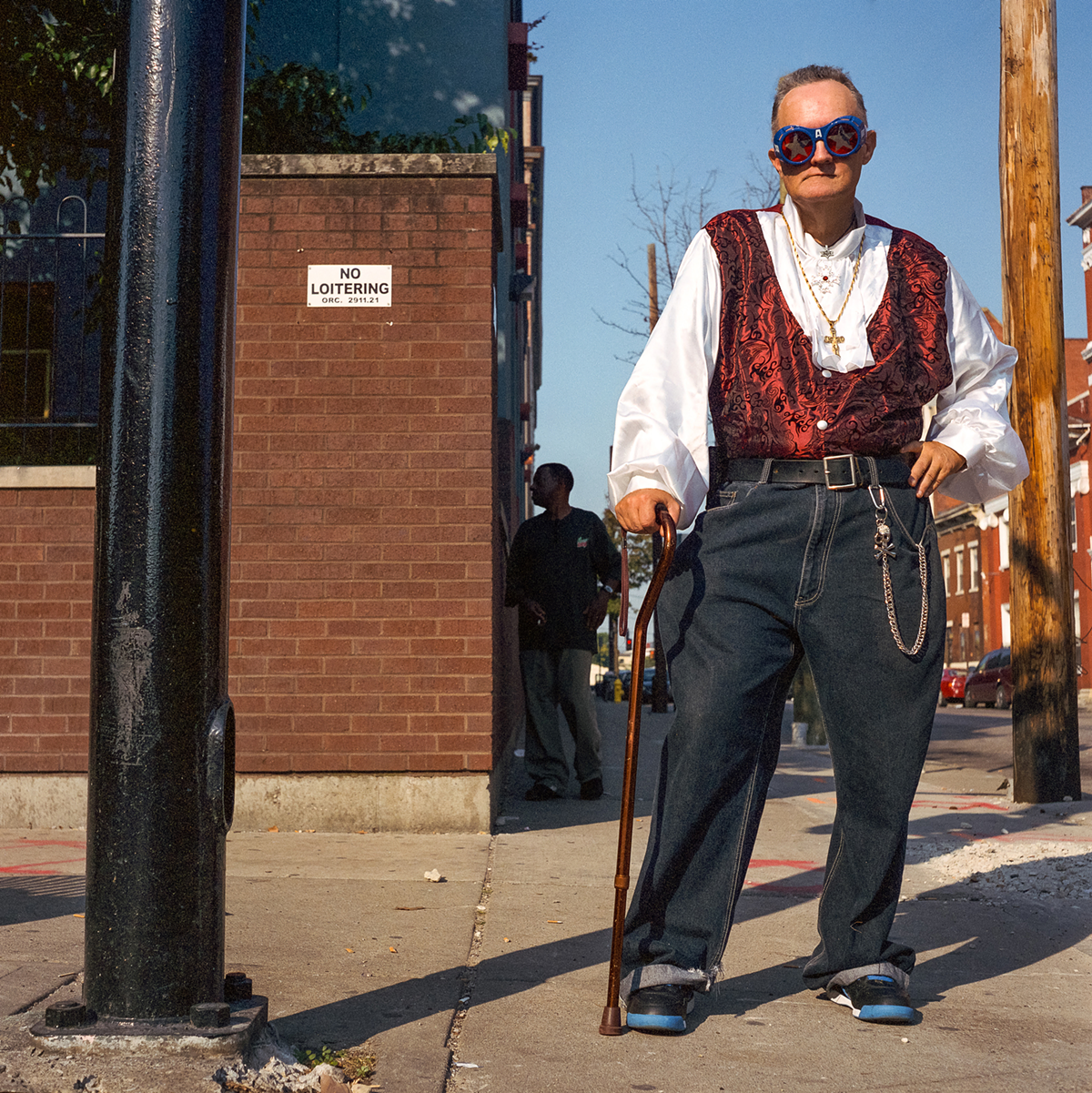
The most gorgeous thing about Second Glances at the Kennedy Heights Arts Center was watching how few visitors did a double-take at seeing traditionally feminine clothing and accessories on masculine forms, or blinked at the thought of women challenging long-held notions of beauty and empowerment. Inspired by work she did with transgender adolescents, textile artist and first-time curator Nancy Gamon set out to explore themes of gender identity through apparel and art. Sea Dax, a non-binary trans artist, bared body and soul in emotional needlework. Pam Kravetz’s bunny ballerina put a new spin on how to be a girly girl. Emily Buddendeck, owner of Northside’s NVISION shop, shed the weight of others’ expectations with “The Shoulders of Giants,” a figure sporting wide, colorful butterfly wings made out of the linebacker-style pads common in businesswomen’s suits of the 1980s. The wish from this show is that soon everyone can leave their secret closets and cocoons behind. Kennedy Heights Arts Center, 6546 Montgomery Road, Kennedy Heights, kennedyarts.org.
The Barry Jenkins-directed If Beale Street Could Talk — based on James Baldwin’s 1974 novel of the same name — is vibrant, poetic and moving with lush colors that meld with each flare of emotion. It explores black love in 1970s Harlem, where Tish is engaged to Fonny, an artist whom she’s been friends with since childhood. She becomes pregnant, but their plans of a life together are derailed when her fiancé is arrested for a crime he didn’t commit. Jenkins knows how to compose characters within a frame. Every color, slant of light, music choice and angle feels carefully orchestrated to evoke the feeling needed. Plus, two actresses in the film have Cincinnati ties: 26-year-old KiKi Layne, who plays Tish, was raised here and graduated from the School for Creative and Performing Arts in 2009. “I think for a long time Hollywood — and media overall — presented it as if there was only one way to talk about the black experience, so I’m definitely very thankful to be at a time in Hollywood where all of that is being challenged,” Layne told CityBeat of her role in the film. And Regina King, as Tish’s mother, won both a Golden Globe and Oscar for Best Supporting Actress for her role. Born in Cincinnati, King’s family later moved to L.A., but she still has family ties here. It’s safe to say that these two have made the Queen City proud.

Ten years since SkateAble vs Non debuted at the now-defunct Feralmade Gallery in Northside, the multimedia skateboard installation returned for a long overdue sequel at People’s Liberty’s Camp Washington Globefront. Arranged by the four members of Cincinnati’s SkateAble collective — a team of scientists, creatives and community organizers who just happen to appreciate skating as an art form — the indoor park doubled as an art installation. Funky cartoons — alligators, cool cats, doggos, scrunched up faces, dinosaurs, jagged skulls — splayed out on quarter-pipes, ramps and spines. The “non” part of the project came in the form of the most chill backyard of 2018, complete with a bat-shaped basketball backboard, wavy pastel pink benches, a skeeball ramp shaped like Fiona the hippo and a literally rocking yellow wooden cow. According to the project statement, SkateAble vs Non provided a skating space “for the community to learn, interact, and experience at all levels.” After the opening, the public was invited to open skate events throughout the run of the event, whether they were a seasoned skate veteran or preferred to keep their feet firmly planted on the ground. SkateAble vs. Non, skateablevsnon.com.
2. 21c Museum Hotel
3. Art Academy of Cincinnati
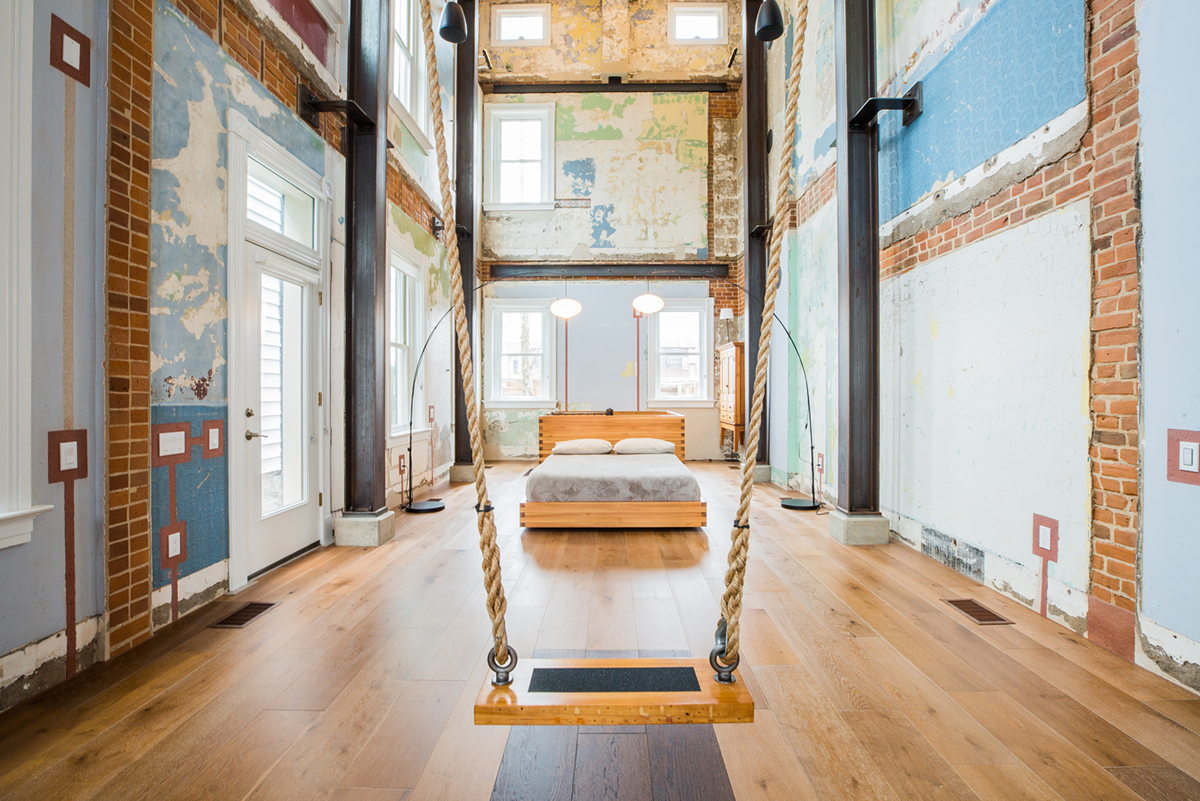
“Art house” traditionally has been a term used in the movie business to connote the type of theaters that favor indie and foreign films over Hollywood fare. But Mark de Jong, a trained artist as well as a renovator/reimaginer of old houses, has a different — and far more literal — meaning for the term. It is a house whose restoration/alteration is done to turn it into, first and foremost, an overall work of art. How people live in it — even whether people live in it — is of secondary concern. De Jong spent three years working on Swing House, a freestanding 1880s three-story residential brick building in Camp Washington, whose location and exterior appearance wouldn’t lead passersby to expect that a major new work of Contemporary art awaits inside. It is called Swing House because de Jong has removed the interior walls and upper floors and built a swing, attached by 30 feet of natural-fiber rope to a newly installed metal beam on the ceiling. The swing is functional in and of itself, yes. But swings are hardly a common inclusion for homes, so this one has far more than a practical use. It represents freedom from architectural convention — it’s a radical departure from our expectations of everyday domesticity. In addition to the swing, the entire space functions as an art house, with layers of past plaster and paint colors communicating with wood furniture that seems to levitate off the ground. The home and its ephemera were the subject of a Contemporary Arts Center exhibit from April to September of 2018 which displayed art objects and material derived or inspired by Swing House, plus new work by de Jong. The exhibit also included special tours of the space. Today, the Swing House is open to the public the first Saturday of the month for tours and is also available to rent on Airbnb. The one-bedroom, one-bathroom home allows guests to stay in and utilize a work of modern architectural art. Swing House, 1373 Avon Place, Camp Washington, swing-house.com.
2. Contemporary Arts Center
3. Taft Museum of Art

2. “Charley Harper’s Beguiled by the Wild”
3. “Fiona and Bibi at the Cincinnati Zoo”
4. “Swing Around Rosie”
5. “Martha, the Last Passenger Pigeon”
6. “Mr. Dynamite”
7. “Ezzard Charles: The Cincinnati Cobra”
8. “Dream Big and Fly High”
9. “Democracy!”
10. “Homecoming (Blue Birds)”
For Covington residents, the mural located on the corner of Fourth and Scott streets is now an iconic cityscape feature. But it began in 2010 with single gray-hued dog painted by collaborative street art group The London Police. They returned in 2016 to expand the mural across the entire side of the building and add a series of their bobble-headed lad illustrations. Phase two of the project served as a tribute to Mike Amann — founder of Covington design agency BLDG who died in 2013 at the age of 33 from colon cancer — whose portrait gives a thumbs up as he rests inside his dog Juno’s chest, which doubles as a space shuttle. “Pennies from Heaven” were also added, aka the funky smiling lads leaving Juno’s belly via conveyor belt. A pastel rosy sun peeks up from the corner, rising eternally above the streets of Covington. And last fall, thanks to Urban Blooms, the mural entered its third living stage: the bottom of the wall is now bordered by real plants. Lily Turner, Urban Blooms’ director of operations, said they got involved when The London Police decided they wanted to incorporate plants in the mural landscape for the creatures to seemingly land on. The installation is fabricated by what Turner calls a custom system that agrees with the curves of the mural. Fourth and Scott streets, Covington, urbanblooms.org/living-walls.
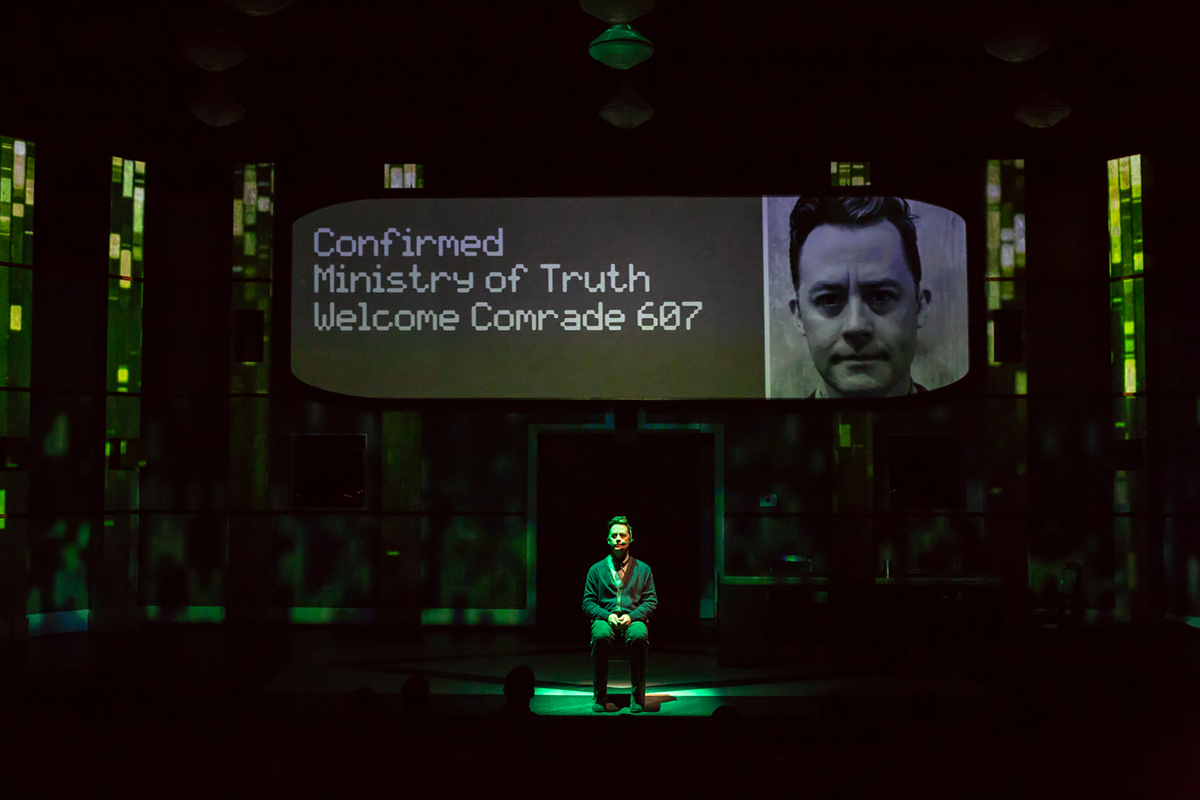
You’d think that George Orwell’s dystopian novel 1984 (written in 1949) would be so passé that it could no longer scare anyone. But when the Cincinnati Shakespeare Company presented a stage adaptation of it in October, the classic theater company used special effects to frighten the bejesus out of everyone with a ticket. Brave Berlin, the creative minds behind 2017’s BLINK light festival, created videos of rats crawling everywhere — even gigantically visible in the second-floor windows of the company’s new theater facing Washington Park. Some folks in Over-the-Rhine are still twitching. Cincinnati Shakespeare Company, 1195 Elm St., Over-the-Rhine, cincyshakes.com.

Thanks to Lin-Manuel Miranda, theater fans — and moden day humans in general — now know more than expected about Alexander Hamilton via Hamilton: An American Musical, an unlikely megahit based on the Founding Father’s life. The touring production of this musical smash that came to Cincinnati’s Aronoff Center for the Arts Feb. 19-March 10, 2019 was no modest knock-off of the Broadway original: the talent was top-notch, the production value was on a par with the show’s New York staging and the performers’ passionate commitment to the material was obvious. The action of Hamilton, like its title character, was non-stop. The two-dozen actors/singers/dancers were constantly in motion, thanks to the incredibly inventive choreography of Tony Award-winner Andy Blankenbuehler, who happens to be a Cincinnati native and a graduate of St. Xavier High School. Because Miranda envisioned this story about America’s founders to be told by a highly diverse cast, the movement ranges from Hip Hop to Broadway choreography, from waltzes to gymnastics. On a scale of 1 to 5, this was a 10 — the rare production that can, as one of Hamilton’s smash musical numbers suggests, “Blow Us All Away.” Broadway in Cincinnati, Aronoff Center for the Arts, 650 Walnut St., Downtown, cincinnati.broadway.com.

BLINK is making its second appearance in Cincinnati in 2019, with a promise to be bigger and brighter than ever. It was announced that the popular light and art festival — which saw a million visitors during its inaugural 2017 event — will spread across the Roebling Bridge into Covington this year. For the first run, light displays and art events stretched from The Banks to the edges of Over-the-Rhine; in 2019, Northern Kentuckians will get a slice. At the expansion’s announcement in October 2018, Dan Reynolds of production company and architectural projection mapping partner Brave Berlin (other partners include The Carol Ann and Ralph V. Haile, Jr./U.S. Bank Foundation, AGAR, ArtWorks and the Cincinnati USA Regional Chamber) said that the greatest part of the fest is that it’s for everyone. “We designed it to be diverse,” he said. “It is for young and old, gay and straight, it is for people who were born in this nation and for people who are visiting this nation and are making this nation their home. It is for everyone.” BLINK will take place Oct. 10-13, 2019 and will again be free and open to the public. BLINK, blinkcincinnati.com.
Six years ago, Cincinnati Playhouse artistic director Blake Robison asked playwright and director KJ Sanchez to consider creating a show that would tell a “quintessentially Cincinnati story.” With Cincinnati King — about the city’s mid-century recording company, King Records — he got exactly what he asked for. Sanchez took the time to interview musicians and others who were part of Syd Nathan’s enterprise in Evanston. Last year marked the 75th anniversary of King’s founding, and it’s likely that the building where this all happened will become a shrine to local music creativity from the 1940s, ’50s and ’60s. If you want to know more about why this is an important piece of Cincinnati history, this was the show for you. Sanchez and others interviewed dozens of people for the script, but she hit the mother lode with Philip Paul, a session drummer for hundreds of King recording sessions. A colorful storyteller with first-hand information who started working at King in the early 1950s, Paul knew Nathan, the bombastic, opinionated owner, as well as Little Willie John, a talented performer who never quite crossed over the bridge to the stardom he deserved. Paul, Nathan and Little Willie were translated into onstage characters for Cincinnati King. (On opening night, the real Philip Paul, now in his 90s, was there to watch.) The show is not a comprehensive history, but rather a collection of anecdotes presented chronologically to create a vivid picture of the stew of talent, diversity, ingenuity and mendacity that transpired at the studio on Brewster Avenue. It tells the story of how King really was back in the day — with musical numbers and a live band to boot. Cincinnati Playhouse in the Park, 962 Mount Adams Circle, Mount Adams, cincyplay.com.
2. Flying Pig Marathon
3. My Furry Valentine

2. St. Cecilia Family Festival
3. CincItalia
What do the names Frank Duveneck, Julian Stanczak, Jim Dine, Charley and Edie Harper, Paul Chidlaw, Petah Coyne, John Ruthven, Maria Longworth Nichols Storer, Tom Wesselmann and Elizabeth Nourse have in common? They are all names of artists who have studied, taught or guest lectured at the Art Academy of Cincinnati in its 150 years as a standout design college. Started in 1869 as the independent, downtown-based McMicken School of Design, it later became part of the new University of Cincinnati in 1871, changing its name to the Art Academy of Cincinnati in 1887 after leaving UC to partner with the new Cincinnati Art Museum and have its own building on that institution’s idyllic Eden Park campus. It separated from the museum in 2005 to move to former commercial buildings at 1212 Jackson St. in what was then still-gritty, not-yet-chic Over-the-Rhine and is now an anchor in that burgeoning urban neighborhood, an accredited nonprofit independent institution with some 200 undergraduates and big plans for growth. With a new book, Art Academy 150: Make Art. Make a Difference, and an exhibit at the Cincinnati Art Museum, Art Academy of Cincinnati at 150: A Celebration in Drawing and Prints, chronicling the history of the academy, many more locals and beyond will know the prestigious and inventive students and work that sprung from the hotbed of talent, including the development of Rookwood Pottery, the creation of the comic strip and iconic names in Modernist wildlife art (the Harpers), Pop art (Wesselmann) and Realism (Nourse). Art Academy of Cincinnati, 1212 Jackson St., Over-the-Rhine, artacademy.edu.
Artist-writer-filmmaker Miranda July, the biggest name among the guests who appeared at Cincinnati’s 2018 FotoFocus Biennial, was positively inspirational in her conversation at Woodward Theater with filmmaker and Syracuse University film assistant professor Kelly Gallagher. She primarily devoted her talk to one of her lesser known but enormously important efforts, the Joanie 4 Jackie underground film network she started for girls and women in 1995. It encouraged them to make movies and connect with others doing the same by compiling the submissions on tapes that July sent to participants. It was empowering to hear her talk about how this provided a creative outlet — and an audience — for the women who were involved. Recognizing its importance to feminist and video history, the Getty Research Institute has acquired its archives.
Since 1925, a Samuel Hannaford-designed house in Walnut Hills has been home to the Cincinnati Federation of Colored Women’s Clubs, an organization whose founding predates the NAACP and the Urban League. Built in 1888 by the same architect behind Music Hall, the brick mansion features Rookwood tile fireplaces, brass chandeliers, bay windows and white-enameled spindles on a grand staircase. During the mid-20th century, more than a thousand members of the federation filed into the home’s 17 rooms to discuss clothing drives, scholarships and other efforts toward racial progress. Today, that figure has dwindled to approximately 55 ladies, yet needs in the black community persist. Fortunately, those few good women recently have been joined by A Few Good Men to revive both the historic clubhouse and the federation for future generations. At 10:30 a.m. each Tuesday, the group of black male buddies gathers at the home for breakfast to raise money for clubhouse repairs, including a hardwood floor and slate roof, and otherwise support the women as they continue their 115-year-old mission of uplifting others. The meals, $15, are open to the public. Cincinnati Federation of Colored Women’s Clubs, 1010 Chapel St., Walnut Hills, 888-823-2922.
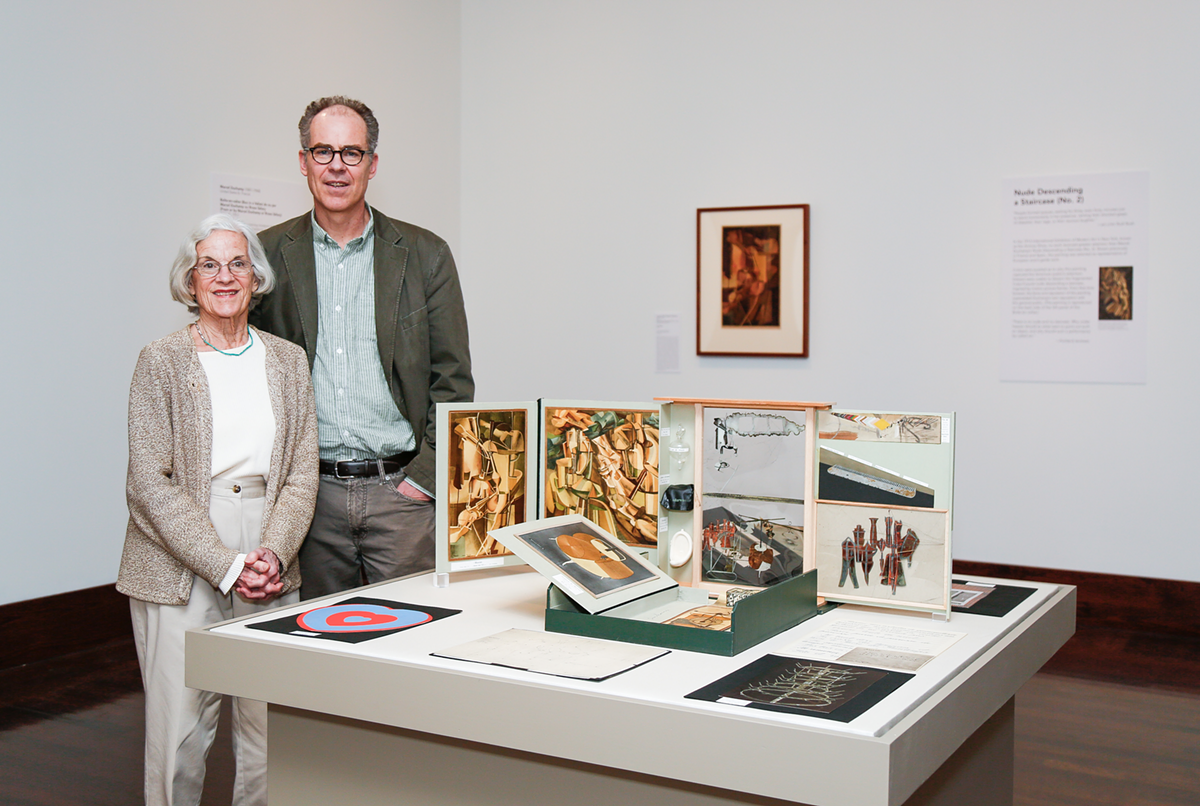
Last year, the Cincinnati Art Museum devoted an exclusive gallery to the French-born artist Marcel Duchamp, who — along with Pablo Picasso and Henri Matisse — is often hailed as one of the three greatest artists of the 20th-century. Until very recently, the Cincinnati Art Museum hadn’t owned enough by Duchamp to merit his own gallery, but after a gift of one of Duchamp’s rare “Boîte-en-Valise (Box in a Valise),” a kind of portable museum consisting of miniature reproductions of his pre-World War II work, was made by Anne and Jeffrey Harrison, the museum opened Marcel Duchamp: Boîte-en-Valise. And it has strong Cincinnati connections. Around 1964, Duchamp himself gave the work to Agnes and Carl Harrison, who lived on a farm in Clermont County. Agnes, whose Cincinnati family’s name was Sattler, was the older sister of Alexina (“Teeny”), who had married Duchamp in 1954 after first being married to Pierre Matisse, an art dealer and son of Henri Matisse. Jeffrey helped his mother (and Agnes’ daughter-in-law) Anne W. Harrison donate the family’s “Boîte” to the museum after her husband, Robert Sattler Harrison, died in 2012 and she moved from the farm. The “Boîte” Duchamp gave to the Harrisons is from 1963’s Series E. It is stunning when you come across it in the art museum now, displayed almost like a sacred text. Prints Curator Kristin Spangenberg has dramatically placed it in the center of the room, under a giant see-through protective cover. Its parts, which slide or fold out from the box, reveal 68 finely rendered miniature replicas, photographs and color reproductions — some on paper, some sculptural — of Duchamp’s own work. And on the label of one miniature, “Coeurs volants (Fluttering Hearts),” is a personal inscription in French: “To Agnes and Carl grande affection Marcel Duchamp.” Cincinnati Art Museum, 953 Eden Park Drive, Mount Adams, cincinnatiartmuseum.org.

Clad in a bubblegum-pink tutu and flower crown, Fiona leaps across the side of Algin Retro Furniture’s building, backdropped in a vibrant blue. It’s a whimsical and downright adorable mural — much like artist, illustrator and Cincinnati USA Regional Chamber event manager Joshua Stout’s other work. “(I like) anything bright,” he says. “I think lots of people go toward gray and muted tones when they’re designing buildings ... so anytime I can add a pop of color, I’m all for it.” The piece is likely inspired by the Cincinnati Ballet’s 2018 production of The Nutcracker, in which the Cincinnati Zoo resident and worldwide celeb’s likeness snagged a spot via a costumed character. Honestly: We love a graceful, body-posi hippo that can dance. Stout’s no stranger to work that dabbles in pop culture — or Fiona. Scroll through his instagram @joshuastoutart and you’ll also see the hippo illustrated as Samantha from ‘80s teen rom-com Sixteen Candles. In case you don’t keep up to date on our city’s growing Fiona mythos, in the artwork she sits across from the San Antonio Zoo’s Timothy — also a young hippo and apparently a suitor of Fiona. Seriously. Fiona Mural, Eighth and Main streets, Downtown.

